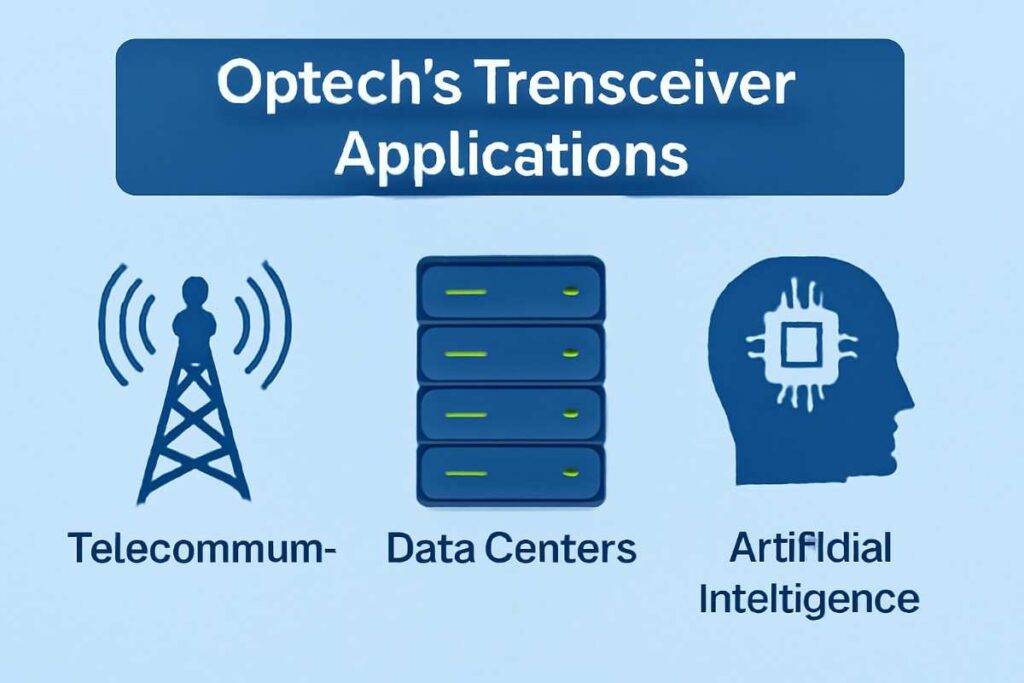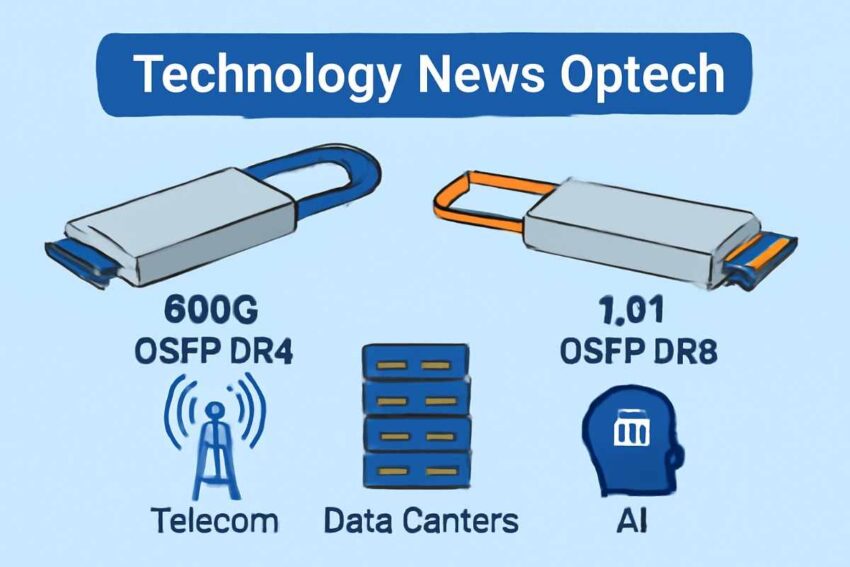Introduction
As the demand for faster, more efficient data transmission technologies continues to rise, Optech is at the forefront of the optical transceiver market. Known for its innovative solutions, Optech has developed products like the 800G OSFP DR4 and 1.6T OSFP DR8, which are reshaping industries such as telecommunications, data centers, and AI. In this article, we explore the key features of these technologies, their real-world applications, and what the future holds for Optech in the rapidly evolving tech landscape.
1. What Makes Optech’s Optical Transceivers Stand Out?
Optech has garnered attention in the tech world for its high-performance optical transceivers. But what sets them apart from competitors?
Optech’s Key Advantages
Optech’s 800G OSFP DR4 and 1.6T OSFP DR8 are not only faster but also more energy-efficient compared to similar products from brands like Cisco and Intel. These transceivers cater to industries that require low-latency, high-bandwidth solutions, such as AI, cloud computing, and 5G telecommunications (Cisco’s optical transceivers).
“The future of optical transceivers lies in solutions that balance high-speed data transmission with energy efficiency,” says Dr. Shreya David, an expert in data centre technologies. “Optech has shown impressive leadership in this area.”
2. How Does Optech Compare to Its Competitors?
Let’s take a closer look at how Optech’s products compare to those from other industry leaders in the optical transceiver space.
Optech 800G OSFP DR4 vs. Cisco and Intel
- Optech’s Performance: Optech’s 800G OSFP DR4 has become the standard for high-speed data centers due to its low power consumption and high scalability (Intel’s optical products).
- Competitor Comparison: While Cisco and Intel offer comparable products, Optech has outpaced them in areas such as AI integration and future-proofing.
| Feature | Optech 800G OSFP DR4 | Optech 1.6T OSFP DR8 | Cisco 800G Transceiver | Intel 800G Transceiver |
|---|---|---|---|---|
| Data Transmission Speed | 800 Gbps | 1.6 Tbps | 800 Gbps | 800 Gbps |
| Energy Efficiency | High | Very High | Moderate | Moderate |
| Latency | Low | Ultra Low | Moderate | High |
| AI & Cloud Computing Support | Yes | Yes | Yes | Yes |
| Application | Data centers, telecom, AI | Data centers, telecom, AI, Big Data | Telecom, Data Centers | Telecom, Data Centers |
| Integration with 5G | Yes | Yes | Yes | Yes |
| Cooling Requirements | Low | Very Low | Moderate | High |
| Industry Compatibility | 5G, AI, Data Centers | 5G, AI, Data Centers, Quantum | 5G, AI | 5G, AI |
Optech 1.6T OSFP DR8: Leading in Speed and Scalability
- Optech’s Innovation: The 1.6T OSFP DR8 allows for data transmission at 1.6 terabits per second, making it the ideal choice for AI and big data applications that demand exceptional speed (Data Center Knowledge on optical innovations).
Case Study: DataCenterX, a leading global data center provider, integrated Optech’s 1.6T OSFP DR8 into its operations, achieving 40% faster data processing speeds and 15% reduction in energy consumption.
3. What Are the Real-World Applications of Optech’s Transceivers?
Optech’s transceivers are not just theoretical solutions; they’re deployed in critical infrastructure worldwide. Here’s a glimpse of their real-world applications.

Telecommunications
In telecom networks, low latency and high throughput are crucial. Optech’s 800G OSFP DR4 helps telecom operators meet these demands, ensuring seamless, high-speed communication across 5G networks.
Data Centers
Data centers rely on high-speed connectivity for cloud computing and data analytics. Optech’s transceivers enable data centers to handle massive data flows efficiently, reducing operational costs while increasing performance.
Artificial Intelligence
Optech’s 1.6T OSFP DR8 supports AI applications that require fast data transmission. For instance, machine learning models are trained using vast datasets, and Optech’s solutions ensure minimal delays in this process.
Personal Experience: “Since adopting Optech’s products, our data center has improved its overall efficiency and reduced our cooling costs significantly,” shares Tom Hargrove, Chief Technology Officer at CloudNext.
4. What Does the Future Hold for Optech and Optical Transceivers?
The optical transceiver market is on the brink of revolutionary changes. Let’s look ahead at what’s coming.
The 400G and Beyond Era
With the increasing demand for faster data transmission, Optech is already preparing for the transition to 400G optical transceivers. These solutions will help tackle the growing need for more data capacity in emerging technologies like 5G, AI, and quantum computing (Lightwave Optical Networking).
AI and Quantum Computing Integration
In the coming years, optical transceivers will be more integrated with AI to optimize data flow and power usage. Additionally, quantum computing will require ultra-fast interconnects that Optech is expected to provide.
Expert Insight: “As we move into the quantum computing era, high-speed optical networks will play a vital role in transmitting quantum data efficiently,” says Dr. Alice Morgan, an expert in quantum computing.
5. Why Should You Choose Optech for Your Networking Needs?
Optech has proven time and again that it’s a leader in optical transceiver technology. Its innovative solutions, commitment to energy efficiency, and future-focused designs make it the top choice for organizations looking to scale their network infrastructure.
Engage with Optech’s Vision for the Future
Are you looking to upgrade your data transmission solutions? Contact Optech today to learn how their high-performance optical transceivers can power your business into the future.
FAQ: Optech Optical Transceivers
Q1: What are optical transceivers used for?
A: Optical transceivers are essential components in communication networks, used to convert electrical signals into optical signals for long-distance data transmission.
Q2: How does Optech’s 1.6T OSFP DR8 benefit AI applications?
A: The 1.6T OSFP DR8 offers ultra-high-speed data transmission, making it ideal for real-time AI applications that require fast data processing.
Q3: Why is energy efficiency important in optical transceivers?
A: Energy efficiency reduces operational costs and environmental impact, which is crucial for businesses scaling their data centers or telecom networks.
Author Bio
Ian Smith is a telecommunications industry expert with over 15 years of experience in optical technologies and network infrastructure. He has worked with leading data centres and telecom companies to optimise their connectivity solutions, specialising in high-performance optical transceivers and next-generation networking technologies.
Stay ahead with the latest updates in technology! Visit Newzhit.com for in-depth coverage, expert insights, and breaking news on the world of Optech and more. Don’t miss out—explore now!

